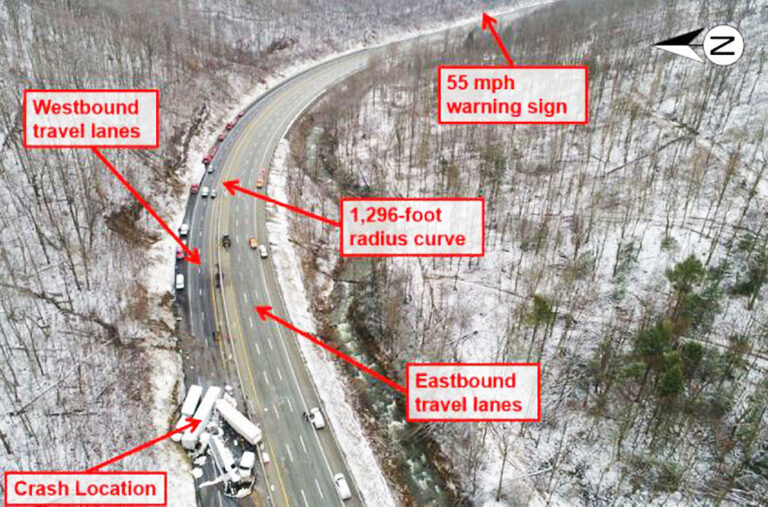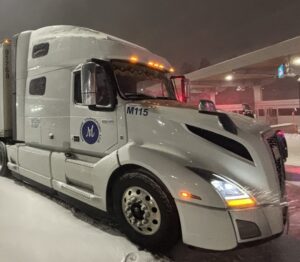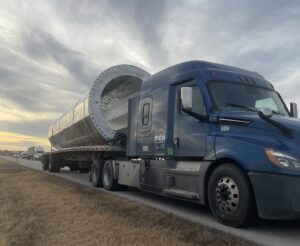WASHINGTON, D.C. — The National Transportation Safety Board (NTSB) has determined that a motorcoach’s loss of control due to unsafe speed led to the deadly multi-vehicle crash near Mt. Pleasant Township, Pennsylvania, on Jan. 5, 2020.
The motorcoach, which was carrying 59 passengers, traveled around a curve at night in light snow. It ran off the right side of the road, hit the adjacent embankment and overturned — blocking both westbound lanes and shoulders of the Pennsylvania Turnpike.
Within seconds, two trucks towing semitrailers behind the motorcoach hit it.
A westbound car and another truck towing a semitrailer drove off the road to avoid the wreckage and came to rest wedged side by side against each other.
The motorcoach driver, two passengers and the driver and co-driver of the second truck died in the crash. Forty-nine of the motorcoach passengers and the co-driver of the first truck were injured.
The NTSB found during its investigation that the regulatory speed limit on the turnpike was 70 miles per hour. An advisory speed sign of 55 mph, posted at the curve where the crash occurred, recommended that motorists reduce their speed before entering.
The motorcoach driver entered the curve at 77 mph and struck the embankment at a speed of about 60 mph before overturning, the NTSB investigation concluded.
The first truck hit the motorcoach at a speed of about 21 mph, causing minor damage. The second truck crashed into the first truck and the motorcoach, causing catastrophic damage; its last recorded speed was 56 mph.
All three trucks involved were equipped with forward collision avoidance systems. The system on the second truck was inoperative at the time of the crash because of a misalignment in the radar on which the system depended.
“This investigation is a tragic reminder that speed kills,” NTSB Chair Jennifer Homendy said. “But it’s about more than driver behavior, which is why our recommendations take a comprehensive approach to promote safe speeds. This includes engineering safety into our policies, regulations and our infrastructure to save lives.”
Contributing to the severity of the crash was the high initial and impact speed of the second truck, the NTSB stated.
The report emphasized that variable speed limit signs might have prevented or mitigated the crash. Also, advanced speed-limiting technology in vehicles could help commercial vehicle drivers avoid exceeding speed limits. Further, connected vehicle technology, if installed on the trucks, might have prevented, or mitigated the crashes, the NTSB concluded.
Based on the findings of the investigation, the NTSB issued safety recommendations to the U.S. Department of Transportation, Federal Highway Administration, the National Highway Traffic Safety Administration, the Federal Motor Carrier Safety Administration, the Federal Communications Commission, the Commonwealth of Pennsylvania and the Pennsylvania Turnpike Commission.
NTSB issued additional safety recommendations to the American Trucking Associations, the Owner-Operator Independent Drivers Association, American Bus Association, the United Motorcoach Association, the Commercial Vehicle Safety Alliance, the FedEx Ground Package System, United Parcel Service of America, the Transport Workers Union, the Amalgamated Transit Union and the International Brotherhood of Teamsters.
The recommendations address issues including excessive speed for wet pavement conditions, the lack of standards for commercial vehicle collision avoidance and mitigation systems to enhance safety (including forward collision avoidance systems and connected vehicle technology) and onboard video event recorder systems for commercial vehicles.
An abstract of the final report, which includes the findings, probable cause, and all safety recommendations, is available at https://go.usa.gov/xtGGs. The full, final report will be published in the next few weeks.
The docket for the investigation is available at http://go.usa.gov/xtGY8
The Trucker News Staff produces engaging content for not only TheTrucker.com, but also The Trucker Newspaper, which has been serving the trucking industry for more than 30 years. With a focus on drivers, the Trucker News Staff aims to provide relevant, objective content pertaining to the trucking segment of the transportation industry. The Trucker News Staff is based in Little Rock, Arkansas.
















Correct me if I’m wrong, but none of this would have happened had the bus driver been driving at the appropriate speed. It was early morning and the only part of the bus that was visible was the bottom of the bus. Considering that, the Fedex Ground driver did a commendable job by getting slowed down to 20mph before striking the underside of the bus. I am surprised NTSB isn’t pushing a mandate for reflective materials on the underside of all vehicles.